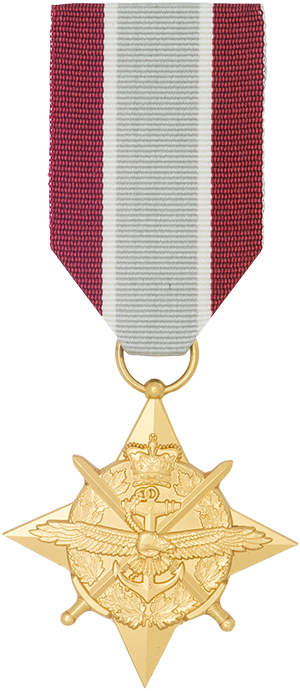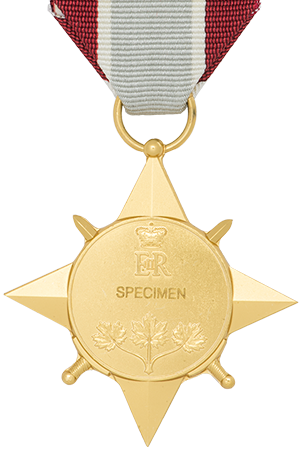General Campaign Star - EXPEDITION (GCS-EXP)
The official description, eligibility, criteria, and history of the General Campaign Star - EXPEDITION (GCS-EXP).


Context
This general service award has been created as a means to recognize in a timelier manner those who participate in operations in the presence of an armed enemy. Rather than creating a new honour for each new Canadian Forces (CF) operation as it arises, the General Campaign Star (GCS) and General Service Medal (GSM) — with their theatre or service specific ribbons — can be awarded in future to honour participation in any operation that meets the criteria provided that the service is not counted towards another service medal.
Eligibility and Criteria
The General Campaign Star (GCS) is awarded to members of the Canadian Forces and members of allied forces working with the Canadian Forces who deploy into a defined theatre of operations to take part in operations in the presence of an armed enemy.
The GCS is always issued with a ribbon specific to the theatre or type of service being recognized, and each ribbon has its own criteria.
This ribbon was created to provide a flexible form of recognition for those missions conducted in the presence of an armed enemy of which size or scope does not justify the creation of a separate ribbon.
1 January 2003 to 4 October 2014
Awarded to military personnel who served in approved locations outside Canada and inside a specific theatre of operations in the presence of an armed enemy for at least 30 cumulative days between 1 January 2003 and 4 October 2014.
- This includes military service within the political boundaries and airspace of Iraq between 20 January 2003 and 4 October 2014, provided the service has not been counted towards another service medal. This means that CAF exchange personnel with American Forces in Iraq are eligible because the US does not award its service medals to foreigners — but those who serve with United Nations Assistance Mission for Iraq (UNAMI) or personnel on exchange with the British Forces are not eligible as they receive a medal for their service from either the United Nations or the United Kingdom.
5 October 2014 to present
Awarded to military personnel who served 14 days cumulative:
- within the political boundaries and airspace of Iraq from 5 October 2014 onward; and/or
- within the political boundaries of Syria, its airspace and territorial waters from 20 April 2015 onward.
Personnel who have eligible service under the 1 January 2003 to 4 October 2014 criteria but did not meet the 30 day criteria, and also have eligible service under the 5 October 2014 onward criteria, shall be allowed to combine all the eligible days of service towards the minimum of 14 cumulative days of eligible service criteria.
Eligible service may be added to the eligibility list for the ribbon by the Chief of the Defence Staff in consultation with Armed Forces Council and on the recommendation of the Canadian Forces Honours Committee, provided the service in question meets the basic criteria and intent of the medal as described in the regulations.
The only members of allied forces eligible are those who serve in missions on behalf of Canada. They are usually foreign exchange personnel who deploy with our units or personnel seconded to the CF specifically to serve in our missions. In all cases, they must be on the CFTPO filling a Canadian position, and they are usually assigned a CF service number. Foreign personnel working in concert with the CF or reporting to a Canadian superior in an international context are not eligible for Canadian service medals.
Aircrew flying into the theatre accumulate one day of service for the first sortie flown on any day. Additional sorties flown on the same day receive no further credit.
The first and last days in theatre count as full days.
Technical Assistance Visits, Staff Inspection Visits, and Staff Assistance Visits in theatre will now be considered eligible service towards the GCS.
Certain other types of visits and inspections do not constitute qualifying service. Specifically, visits for the purpose of leadership, familiarization, ceremonial, or morale by civilian or military VIPs and other similar administrative activities are excluded from qualification.
Any person who dies or is evacuated because of injuries or medical reasons directly attributable to service is deemed to have satisfied the time criteria set out above. Any recipient of the Star who dies or is evacuated because of injuries or medical reasons directly attributable to service shall be credited the entire period the person would have served should the person have completed their tour of duty for the purpose of calculating eligibility towards Rotation Bars.
When a person meets the criteria for the GCS-EXP or a Bar to it and the GSM-EXP or a Bar to it within a period of 180 days, the person shall only be awarded the GCS or a Bar to it. In other words, one cannot earn both the GCS and the GSM for EXP (or bars to them) during a six-month period.
The Star and Rotation Bars shall be awarded for honourable service.
For more details, consult the Eligible service list.
Description
The GCS is a gold-coloured four-pointed star, 44 mm across, representing the cardinal points of a compass bearing on the obverse, built-up in order from the back: a wreath of maple leaves terminating at the top with the Royal Crown, two crossed swords, the blades and hilts forming four additional points to the star, an anchor and a flying eagle. The wreath represents honour, the maple leaves represent Canada, the anchor, crossed swords and eagle represent the three services of the Canadian Forces and the Crown represents the King of Canada and his role as the fount of all honours. On the reverse appear within a raised circle, from top to bottom: the Royal Cypher ensigned by the Royal Crown, a plain space for engraving, and three maple leaves on one stem.
The ribbon passes through a ring attached to a small ball at the top point of the star.
The ribbon is 32 mm wide with a central stripe of light grey (12 mm), on either side of which are stripes of white (2 mm) and red (8 mm). Red and white are the official colours of Canada as appointed by King George V in 1921.
The rotation bars for the Star are gold in colour with a raised edge and bear either one or five maple leaves.
Bar(s)
Rotation bars have been created to recognize long periods of service in a theatre.
Recipients of the GCS may be awarded a first Rotation Bar after a total of 210 days of eligible service, including the days taken into account for the award of the original medal, and additional bars are awarded for each subsequent period of 180 days.
One bar bearing five maple leaves is worn in lieu of five bars bearing one maple leaf.
Wearing
The GCS-EXP shall be worn in the sequence prescribed in the Canadian Orders, Decorations and Medals Directive, and in the following manner:
- On the left breast, suspended from the ribbon described above, between the General Campaign Star with SOUTH-WEST ASIA ribbon and the General Service Medal with ALLIED FORCE ribbon;
- One bar is worn centered on the ribbon;
- If multiple bars have been awarded, they shall be evenly spaced on the ribbon in the order earned, with the first bar earned worn the closest to the Star; and
- When the undress ribbon is worn, a silver maple leaf shall be worn centered on the ribbon of the Medal to indicate the award of a Rotation Bar, a gold maple leaf shall be worn to indicate the award of a second Rotation Bar and a red maple leaf shall be worn to indicate the award of a third Rotation Bar. If more than three Rotation Bars have been awarded, those devices shall be worn in combination so as to indicate the total number of Bars awarded.
Postnominals
The use of a post-nominal is not authorized for this medal.
Historical notes
The GCS and GSM were created by Her Majesty Queen Elizabeth II in March 2004. Initially both medals were issued each with only one ribbon (those currently used for South-West Asia) with bars specifying the operation being recognized. Two bars were created, namely ALLIED FORCE and ISAF+FIAS.
The inaugural ceremony took place on 29 November 2004 in the ballroom of Rideau Hall in Ottawa. On this occasion, Her Excellency, the Right Honourable Adrienne Clarkson, CC, CMM, COM, CD, Governor General and Commander-in-Chief of Canada, presented the Star to 28 representative recipients (8 with ALLIED FORCE bar and 20 with ISAF+FIAS bar). The first presentations of the General Service Medal were also made during that event.
In 2009, the GCS and GSM were modified so that the existing bars were abolished, being replaced with theatre or service-specific ribbons thus allowing the use of bars to recognize multiple rotations where appropriate. The EXPEDITION ribbon was created at the same time to provide a flexible tool of recognition for operations for which it is not possible or practical to create a separate ribbon.
Captain Carl Gauthier of the Directorate of History and Heritage, DND, designed the award. The Canadian Heraldic Authority at the Chancellery of Honours, Rideau Hall, completed the final artwork.
The Star is engraved on the reverse with the service number, abbreviated substantive rank, initials and name of the recipient.
As of 31 December 2024, 4,844 awards had been made.